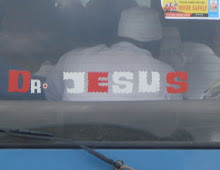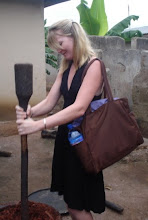My second weekend in Africa was spent in paradise. I drank milk from fresh coconuts, swam in the warmest ocean I’ve ever been in and walked through the top of a rainforest on swinging wooden bridges.
We loaded our big blue bus very early Friday morning and battled traffic in the crowded streets of Accra. We finally broke free from traffic and headed for the cleaner air of Cape Coast and Elmina, two neighboring cities up the coast from Accra. While others dozed on the long car ride, I took in the surroundings—the landscape varies greatly from village to village. Mud huts instead of tin shacks lined the highway; women balanced bowls of raw fish on their heads instead of brown nuts (peanuts). We passed beautiful sprawling fields of pineapple plantations and saw bright red birds that look like balls of fire as they flap upward into the clear blue sky.
Three hours later, we arrived at Cape Coast Castle, one of many British slave trade castles along the Ghanaian coastline. The castle was immaculately preserved, and I can’t describe in words how it felt to walk on the same grounds as slaves had centuries ago. A man who I could barely understand (but whose compassion made me understand) gave us a tour. He led us through the male slave dungeons, where as many as 150 men were held with human waste up to their knees in an area no larger than a small bedroom. The British had tiny holes where they could view the men, and those who dared to disrespect them were thrown into torture chambers or were condemned. We saw the scratches of prisoners on the walls and could almost hear the building moan with its sad, horrifying tale. We were led through the female dungeons which were similar to the male dungeons except slightly larger to accommodate for children. Here, the British used the spy holes to pick which women they “fancied.” They would lead these women out of the dungeon and take them upstairs to rape them.
I can’t imagine the fear and anguish the enslaved must have felt. As we walked through the “Door of No Return” where the British led the slaves to the ships, I couldn’t stop thinking about what a monstrosity slavery was (and in some places still is). How can human beings treat each other in such a way? While the slave castle was extremely disturbing for me, I think it’s something that every person in the world needs to see. Such atrocities should be remembered in our history, not just discarded like white men once discarded their African brothers. Children should know that Americans are not the heroes their history texts make them out to be; they deserve to know that we, too, made huge mistakes in our history and are now moving on and growing up as a nation. Or maybe we’re not—but that’s a whole different topic.
After the tour, our minds were buzzing and our stomachs churning. The bus whizzed past white sand beaches dotted with huge palm trees, the warm waves crashing on the shore. We pulled into our hotel for the weekend—well, not exactly a hotel, but more like a resort. The place was beautiful, with little bungalows facing our private beach, an inviting swimming pool, palm trees, a small golf course and even a crocodile pond. Our rooms were air-conditioned and our shower ran hot water, though rather noisily. Immediately, we peeled off out sticky clothes and changed into bathing suits. Never has diving into a pool felt so good—the water was perfect.
We ordered dinner, and while some opted for chicken and chips (fries), I had more joloaff rice, which has become a personal favorite. The rice is rather spicy, but bearable even in hot weather. In fact, most all of the food here has proven rather delicious and I’ve even been brave enough to sample some more trying dishes, such as red red (beans and some sort of curry). Also, I never knew how good fried plantains were!
After dinner, we spent while sitting by the ocean listening to the waves beating against the shore. The sky here is so clear that it seems as if you could reach up into the sky and pluck down a shimmering star to put in a little jar beside your bed. Being here reminds me of how I’m really not destined to be a city girl—it reminds me that I really must be somewhere where I can see the stars because only then is my heart really full.
I woke up early on Saturday morning to go for a stroll along the beach. I passed by women with bunches of wood tied up and balanced perfectly on their heads. They make it look so easy. The air is sticky here, even more so than in Accra, but rather than dirt and pollution sticking to you it’s sand and salt from the cool ocean breeze.
Issac, our driver, picked us up at the hotel lobby (it’s called Coconut Grove Beach Resort, by the way). He’s a funny little man who spokes broken English but loves football. He wore a brightly colored traditional shirt with Adinkra stamps all over it—I wish I knew all the symbols. We drove through tiny villages, where young men stood in a line and pulled in unison to reel in their fishing nets. The older men and young children sat beneath shaded porches untangling the nets for another day’s use. Women carried water from the ocean to the village, trying to remain steady on the unstable sand.
After 45 minutes, we arrived at Kakum National Park. Immediately, the air feels more humid (was that even possible?). While waiting for our nature walk to start, we toured the museum and took pictures of a funny lizard with an orange head. Our tour guide led us through the dense jungle, up through twisted vines and slippery rocks. After another short wait, we finally arrived at the bridges. This bridge project is part of Ghana’s endeavors in ecotourism, and by the looks of the line they’ve done quite well for themselves.
The bridges hang hundreds of feet above ground, secured between two massive tress and surrounded on either side by rope netting. They look pretty steady, but as soon as I step my foot onto the first bridge my heart sinks. I’m not afraid of heights necessarily, but there is just something that feels out of place when you’re walking across a bridge swinging around in the top of the rainforest. It’s just not quite right. I bite the bullet, though, and as soon as both feet are on and about halfway across the bridge, I can’t get enough. Looking out over the rainforest is exactly how I pictured Africa. There are huge safari-like trees across the distance and lush branches of exotic looking flowers hang below us. There are seven bridges and I glided over each and every one. I’ll admit that the swaying was a little unsettling but it was almost too beautiful all around me to even notice. Almost.
After the nature walk, we once again boarded our bus and headed to Han’s Cottage Restaurant. We didn’t really know what to expect, but Leslie told us it would be “wild.” We sat at a table on the edge of a small, dirty pond. Looking around, we immediately spotted something with a spiked back swimming suspiciously across the water—a crocodile! We saw three or four during our lunch of plantains, rice, chicken, pasta and fish. One got so close that we could touch it, but I opted against that idea.
Back at the resort, I went for a swim in the ocean and found some beautiful shells. Like I said, the water here is so warm—in fact, it’s many times warmer than our shower at home in Accra. I washed the salt off my skin in the pool and immediately changed into longer pants. I ventured around back and found Paul, who saddled up a young mare named Lucky for me to ride. I’d talked with him earlier that day about riding on the beach, and had come back to take him up on the offer. The English saddle was old and cracked and far too small for me, but I made due. Lucky is a pony, technically, but Paul tells me that she used to race and is only six years old. Immediately, a small alarm went off in my head—I’ll have to be careful with this one! Paul leads me to the beach with his mangy dog Tigo following closely behind. Lucky pins her ears back as I take off on my long walk, but seems to warm up as I sing to her and stroke her neck. She’s a sweet horse until I ask her to canter. She immediately swishes her tail and puts her head down—I know what’s coming next. Sure enough, she explodes into a fit of bucking and crowhopping. I begin to wonder if Paul meant that she was a rodeo horse, not a racer. I managed to hang on until I can get her to stop and kick myself off her narrow back. At least I go to ride a horse on the beach, and in Africa at that! Two of my friends, Ryan and Mollie, get on Lucky after me. Ryan leads Mollie and vice versa—they’re a fairly serious couple, so they do things like that I guess. Anyway, sure enough Lucky has had enough of the riding thing and charges with Ryan (who has never ridden a horse before) on his back. He managed to hang on for a few strides, but eventually ended up with a mouth full of sand. All that resulted from his fall was a bruise and a few sore muscles—looks like Lucky was meant to stay on the track.
On our last night at the Coconut Grove, our friend Daniel (who accompanied us on the trip and who used to manage the resort) had a bonfire lit for us on the beach. It felt nice to smell a campfire as we sipped palm wine and listened to the sounds of the ocean. Morning came far too fast in our air conditioned rooms, but we eventually fell out of bed and toured another castle, this one built by the Portuguese and occupied eventually by the Dutch. Elmina Castle was very similar to the first castle, and you could almost feel the spirits of that place watching you from the dark corners. Needless to say, I was happy to leave. While I think it’s an important part of history, it’s almost unbearable in its gravity.
On the way out of town, we stopped at an NGO called “Global Mamas.” Its mission is to rehabilitate women who may be prostituting themselves or otherwise struggling by teaching them business skills. Among other things, this organization creates clothing, purses and household items to sell in its stores. It was inspiring to visit such a place where such great inspiration happens.
The weekend flew by, and everyone starts their internships tomorrow. I start mine on Wednesday, though, because our office is closed for Republic Day, similar to the 4th of July for the celebration of Ghanaian Independence. Wish me luck!
Getting in an 8th Grade Frame of Mind
15 years ago













































1 comment:
Hello Logan, Eryn forwarded you blog address so I could track your adventures. It is so great what you are getting to do and experience. We are all proud of you and what you are accomplishing. Love the pictures and the swinging bridge (lends an "Indiana Jones" feel to your travels). Stay safe and we will compare our "village" experiences when we meet again. (Although Nightmute is not quit so exotic). Love, Momma Cheryl
Post a Comment